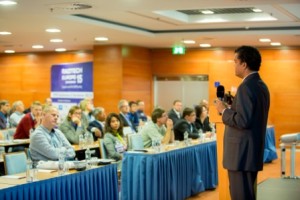RadTech Europe Conference 2015 explores UV/EB curing technology
 This year’s RadTech Europe Conference in Prague proved how dynamic and diversified the world of radiation curing is today. For the benefit of some 440 delegates, 60 speakers addressed the plethora of chemistries, technologies, and applications that today employ UV and EB curing, in an intense and wide-ranging programme, in a new, more technically-focussed format, and held at a new location.
This year’s RadTech Europe Conference in Prague proved how dynamic and diversified the world of radiation curing is today. For the benefit of some 440 delegates, 60 speakers addressed the plethora of chemistries, technologies, and applications that today employ UV and EB curing, in an intense and wide-ranging programme, in a new, more technically-focussed format, and held at a new location.
The formal agenda was partnered by a parallel exhibition featuring leading technology providers, incorporating a small theatre where exhibitors could introduce their latest products.
Prague’s Clarion Congress Hotel proved to be an ideal combination of spacious first-class conference/exhibition facilities for the new face of the conference, which was headlined UV/EB Now: new place, new format, new applications.
RadTech Europe’s president, David Helsby, explained the association’s mission as ‘to create an event that, in every respect, provides real value for the delegates.’ Following the AGM, conference chairman Dawn Skinner, of Heraeus Noblelight America, opened the plenary conference session. It featured a challenging, thought-provoking keynote from Lars Sonderegger of behavioural management specialists, Quantonomics, on the key topic of the most effective routes to innovation and value creation.
US and European market overviews followed this. A growth rate of more than seven per cent is expected in the US over the next two years for the current up-and-coming applications – 3D printing, inkjet, and fingernail decoration. Also, David Helsby confirmed that the DACH region is still Europe’s largest consumer of UV/EB technologies, representing 42 per cent of the market. Identifying major trends, he examined the raft of regulatory compliance requirements regarding formal EU legislation and how unpredictable issues – crude oil prices, raw material costs, freight, interest rates, and currency – affect the industry?
The plenary session concluded with RadTech Europe prize presentations conducted by the president. The long-established, prestigious Paul Dufour Award for the best conference paper was awarded to Sandra Schlögl of the Polymer Competence Centre, Leoben for her paper on the formation of 3D structures in offset printing techniques by UV induced ink foaming.
Simone Radl, also from the Polymer Competence Centre, Leoben, was presented with the RadTech Europe Advanced Development Award 2015, for her groundbreaking presentation on smart ‘photoswitchable’ composite materials for self-healing and recycling strategies.
Parallel programmes
An impressive succession of parallel programmes then split the delegate base into different streams for the remainder of the three days, covering advances in a wide range of industry sectors.
UV LED technology was the focus of the session chaired by Paul Kelly of Perstorp (UK), which attracted extremely high attendance – evidence of the considerable activity and interest in this particular field. Content spanned new resin and formulation developments; improved surface cure with deep-UVC LEDs; the impact on UV curing applications of advances in UV LED technology; developments in UV LED equipment; and solutions to enhance the performance of UV LED and low- energy-curable systems.
The session on 3D printing/additive manufacturing, chaired by Susanne Piontek, BASF Coatings (DE), opened with an overview of the history and status quo from the 3D Printing Association’s membership director Ian Ferguson (UK). The session went on to record developments in different aspects of 3D UV inkjet printing and exciting advances in photopolymerisation for human tissue engineering.
Coatings and specialist formulations are also an area of particular current interest, and Christophe Vergé of Sartomer (FR) chaired a session that looked at soft-touch coatings that are 100 per cent UV-curable; self-replenishing hydrophobic coatings; a novel IR and UV hybrid irradiation process for photon delivery; and the outlook for UV/EB’s role in automotive coatings were all discussed.
The closing conference session, chaired by Dawn Skinner (UK), looked at some of the key advances, including the use of integrating sphere technology for uniform UV curing; achieving precise UV LED measurements; and future directions for EB systems.


